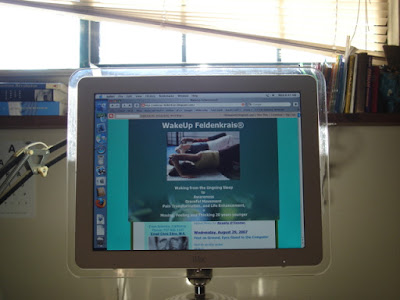
As per my
version of life on Earth:
we have three choices:
high functioning robot
low functioning robot
awake person
The huge temptation
in all the "healing" and "helping" work
is to give people a program
a recipe
a rule
a set of rules
that will get them from low functioning robot
to high functioning
believe it or not
this even happens in the Feldenkrais world,
though hopefully not
in the Wake Up Feldenkrais world
one example of this
is a back help DVD
which luckily I get to return,
and i will return
because though purporting to be
a blend of Feldenkrais and Physical Therapy
ends up giving people
set rules
and set programs for their legs and hips
as the way out of back pain
it might even work,
except this isn't "working"
the way a baby learns to crawl
by discovering and exploring
and having deep organic
natural learning
this is:
I'll show you the Right Way
learning
which is quicker
and maybe makes immediate changes more
obvious,
but in the long run,
you've just substituted a higher level
of automatic behavior
So, now
today's main topic:
a new fad on Feldy Forum
is the combo of Feldenkrais and
when Moshe Feldenkrais met Milton Erickson
whom i've written about in my healthetc blog
( see
Ericksonian hypnosis,
which actually presents a picture of hypnosis
as a more aware process than
I'm critiquing in the following mini-essay)
anyway both are genius
and both access new behaviors
and allow people to make amazing shifts
and here's what i came across in an
old Feldenkrais Journal (#8, 1993)
from an article called
Getting Ourselves Out of Trance
a book review by Carl Ginsburg
of the book :
Trances People Live: Healing Approaches
in Quantum Psychology
(excuse me while i gag myself a little for the "quantum"
bit,
but hey,
this was before Deepak
and the Secret
and what the bleep bleep):
Anyway, here's a central quote from the book:
Really Important,
I opine:
"In the Ericksonian model, I learned that trance states
could be induced or facilitated as a therapeutic intervention
to interrupt the symptom structure
and access
unconscious potentials and resources.
In my breakthrough moment
those puzzle pieces came together in an entirely new pattern:
I saw that although trance states can be used
to evoke resources and change
on an unconscious level,
they can also be --are used--
to create the symptomatology with which we all struggle.
I saw that the person who brings his or her problems
and symptoms
to me
is already in a trance state, and
it is this very trance state that is interrupting
his or her experience of the present moment,
blocking unconscious problems and symptoms.
The therapeutic intervention then involves working
with the trance state
the person has already created
(which de-hypnotizes them)
rather than inducing or facilitating another
kind of trance that may or may not
be pivotal to the patient's symptom structure."
La, la:
this means:
in we go,
in a trance:
do we want to come out with a
better trance
(witness the popularity of trance dance,
and even trance dance yoga)
or do we want to come
out
awake.
rhetorical question
except
that we can be asleep
when we give
what sounds like
the Right Answer
ciao,
chris
p.s.
if you peruse
the links
you'll find one to an article
by Mark Reese,
may his soul rest in Peace,
on Milton and Moshe.



